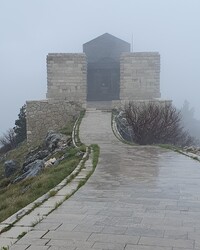Photo. Entrance to the Mausoleum on the summit of mount Lovćen in Montenegro. © Travel Explorations.
Exploring Mount Lovćen on a foggy day was for me a mystical and atmospheric experience. At the summit of Mount Lovćen, the mausoleum dedicated to Petar II Petrović-Njegoš, the fogg was very tight and it was not much to see around. My climb to the mausoleum felt ethereal as the mist enveloped the path.
Anyway I had to think positive. Although fog obscured some views, it also creates a unique atmosphere. I knew that on clear days, the panoramic vistas from the top offer breathtaking views of the Bay of Kotor, the Adriatic Sea, and the surrounding mountains. The fog added also mysterious quality to the landscape, making it an excellent time for photography. So I took my time to capture the interplay of light and mist among steep hillsides, the trees and rocky terrain.
The Mausoleum of Njegoš, also known as the Mausoleum of Petar II Petrović-Njegoš, is a prominent historical and cultural site located on the peak of Mount Lovćen in Montenegro. It is dedicated to Petar II Petrović-Njegoš, a revered Montenegrin prince-bishop, poet, and philosopher.
Reaching the mausoleum involves a drive up the narrow, curvy, winding roads of Mount Lovćen, followed by climbing a series of steps. It is advisable to wear comfortable shoes and be prepared for changing weather conditions.Visitors enter through a grand staircase that leads to the mausoleum, which is situated at an altitude of 1,657 meters (5,436 feet). Lovćen’s star attraction, this magnificent mausoleum (built 1970 to 1974) sits at the top of its second-highest peak, Jezerski Vrh (1657m). Took the 461 steps up to the entry where two granite giantesses guard the tomb of Montenegro’s greatest hero. Inside, under a golden mosaic canopy, a 28-tonne Petar II Petrović Njegoš rests in the wings of an eagle, carved from a single block of black granite.
Inside, there is a large statue of Njegoš, created by Ivan Meštrović. The statue depicts Njegoš in a thoughtful pose, reflecting his intellectual legacy. Njegoš and his burial spot used to be mentioned in the popular Montenegrin folk song Oj, svijetla majska zoro which (with revised lyrics) has been the national anthem of Montenegro since 2004. Biljarda (Billiard House): Once the residence of Petar II Petrović-Njegoš, it now serves as a museum dedicated to his life and work.
From 1945 to 1992, the previous Njegoš Testament Church was featured in the coat of arms of the Socialist Republic of Montenegro and from 1992 to 1994 in the coat of arms of the Republic of Montenegro. The actual tomb lies below, and a path at the rear leads to a dramatic circular viewing platform providing the same utterly spectacular views that caused George Bernard Shaw to exclaim, ‘Am I in paradise or on the moon?’.
Petar II Petrović-Njegoš was born in 1813. He was the ruler of Montenegro and is considered one of the greatest poets in Montenegrin literature. His works, especially "The Mountain Wreath," are celebrated for their philosophical depth and national significance.
The original chapel on Mount Lovćen was built by Njegoš himself, who wished to be buried there. However, this chapel was destroyed during World War I. The current mausoleum, designed by the Croatian sculptor Ivan Meštrović, was completed in 1974.
The mausoleum features a combination of modernist and traditional Montenegrin architectural elements. It is made of dark granite and marble, symbolizing the strength and endurance of the Montenegrin people.
Legacy of Njegoš: Visiting the mausoleum provides a deep insight into the life and legacy of Petar II Petrović-Njegoš. His contributions to Montenegrin culture, literature, and national identity are profoundly commemorated at this site.
By exploring the Mausoleum of Njegoš, visitors can connect with Montenegro's rich cultural heritage and appreciate the natural beauty that surrounds this significant historical monument.
The Mausoleum of Njegoš is a mausoleum interring Petar II Petrović-Njegoš located on the top of Mount Lovćen. The mausoleum is located twenty-one kilometres via asphalt road from near-by Cetinje and it was built on the idea of Croatian sculptor Ivan Meštrović. It was built on the same location of the Njegoš Testament Church which Njegoš had built in 1845 with the intention of being buried there and which he dedicated to his predecessor Petar I Petrović-Njegoš (who is canonized as Saint Peter of Cetinje in the Serbian Orthodox Church).
The church suffered damage from bombardment in both World Wars. In 1974, despite protest from the Metropolitanate of Montenegro and the Littoral and local Orthodox Christians, the old church was ordered demolished by a commission of the League of Communists of Montenegro led by Veljko Milatović and today's mausoleum was built.
The location offers breathtaking panoramic views of the surrounding landscape, including the Bay of Kotor, the Adriatic Sea, and the mountainous regions of Montenegro, but on my visit this day I couldn`t see much. Anyway I had to enjoy my experience as it turned.
Stein Morten Lund, May 2024
Additional information
Read more about the Mausoleum on Mount Lovćen on Wikipedia.
There are several trails in Lovćen National Park suitable for different levels of hikers. The trail to the Njegoš Mausoleum is the most popular.
Nearby attractions:
- Lovćen National Park: it`s possible to combine a trip to the mausoleum with a visit to this park, which offers various outdoor activities like hiking, bird watching, and exploring natural landscapes.
- Cetinje: is a historic town located at the base of Mount Lovćen. It was the old royal capital of Montenegro and remains a cultural and historical hub. The town is known for its well-preserved architecture, museums, and cultural institutions, reflecting Montenegro’s rich history. Cetinje Monastery, National Museum of Montenegro - a former royal palace and Biljarda (Billiard House).












